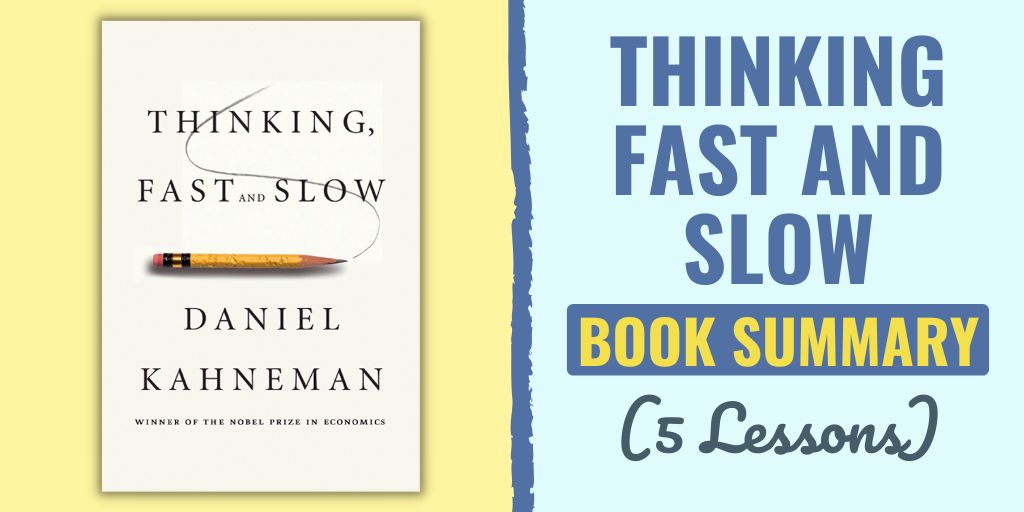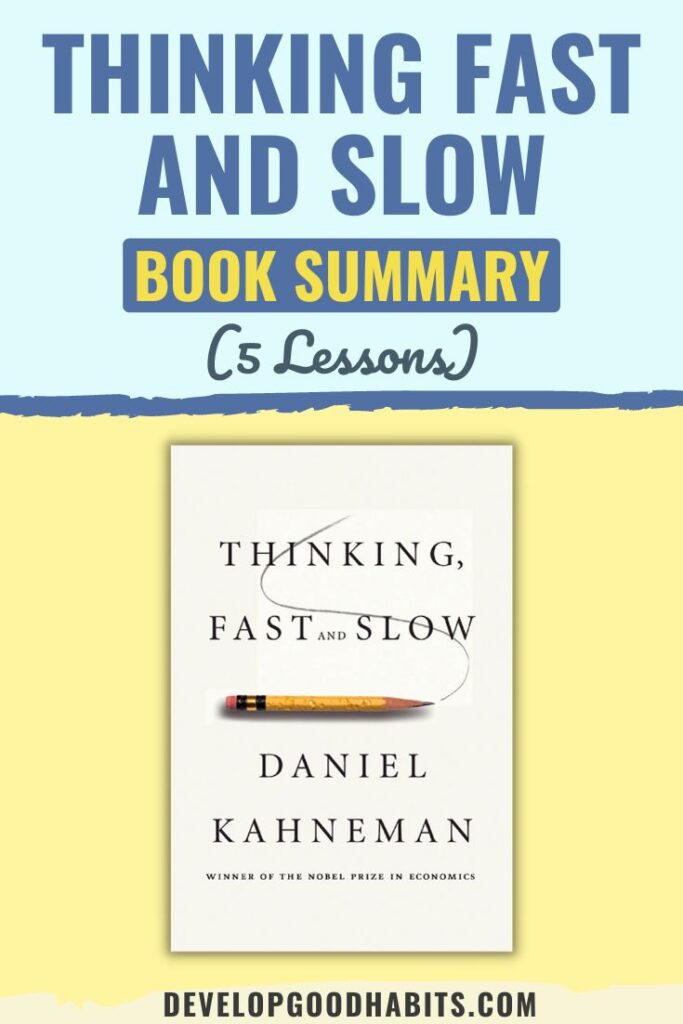There might be affiliate links on this page, which means we get a small commission of anything you buy. As an Amazon Associate we earn from qualifying purchases. Please do your own research before making any online purchase.
Did you know that you can improve your capacity to think deeply? You'll learn to do just that in Daniel Kahneman’s book Thinking Fast and Slow.
The main premise of this book is a deep delve into the intricacies of human decision-making and cognition.
Once you learn how these systems work in the human mind, you’ll be able to harness them for your own purposes, or at least be aware when you’re using the wrong system to come to conclusions.
In this article, we’ll delve into the two systems that Daniel Kahneman believes are crucial to how all human cognition functions. We’ll also show you five lessons you can learn to help you either study the book if you have it or to help you decide if this book has a place in your collection.
Now, if you’d like to check out the book, you can read it on your Kindle, get a print copy, or listen to the audiobook.
Let’s start with…
Lesson 1: The Two Systems of Thinking
As you may suspect from the book title, Kahneman believes there are two symptoms that all humans use to do the bulk of their cognition.
They are referred to as System 1 and System 2. It’s important to note that one system is not strictly better than the other, but there are situations where using one system over the other will lead to better results.
System 1
System 1 is the part of your brain that operates automatically, intuitively, and involuntarily. It's the system responsible for quick decision-making, such as calculating simple math problems, reading short sentences, and recognizing objects belonging to a specific category.
System 1 helps you in everyday life by allowing you to quickly process information and navigate through the world around you.
In Thinking, Fast and Slow, Daniel Kahneman explains that System 1 operates:
System 2
On the other hand, System 2 is the more analytical, deliberate, and rational part of your brain. It's responsible for more complex thoughts, decisions, and problem-solving.
This system requires conscious effort and attention, and can often be slower and more deliberate in its approach.
In contrast to System 1, System 2 operates:
Throughout the book, Kahneman explores how these two systems interact and affect your decision-making process.
To maintain a healthy balance between the two systems, it's essential to be aware of the limitations of each system and develop strategies to encourage optimal decision-making.
Also if you want to learn how to think out of the box, then check out this video:
Lesson 2: Your Heuristics and Biases
Heuristics are mental shortcuts that allow you to make decisions and solve problems quickly, but sometimes at the cost of accuracy.
Biases are cognitive tendencies that can lead you to make systematic errors in your thinking.
Let's take a closer look at some specific heuristics and biases Kahneman discusses.
Availability Heuristic
The availability heuristic is the mental shortcut you take when you judge the probability of an event based on the ease with which instances come to mind.
For example, you might think plane crashes are more common than they actually are because they receive extensive media coverage. To mitigate the effects of this heuristic:
Representativeness Heuristic
The representativeness heuristic involves estimating the likelihood of an event or outcome based on its similarity to a stereotype or a known category.
When relying on the representativeness heuristic, you might make judgments solely based on appearances, rather than considering the broader context. To counteract this heuristic:
Anchoring Effect
The anchoring effect occurs when you rely too heavily on an initial piece of information when making decisions.
This can lead to your estimates and judgments being biased towards that anchor, even if it's irrelevant or inaccurate. To reduce the impact of anchoring:
Understanding these heuristics and biases can help you make better decisions and improve your overall critical thinking. By being aware of these mental shortcuts and their potential pitfalls, you can make more informed choices and avoid common cognitive traps.
Lesson 3: The Dangers of Overconfidence and Optimism
Kahneman explains how overconfidence and optimism can significantly impact your decision-making. This section will explore these concepts and highlight how they apply to your thinking process.
This comes down to underestimating how achievable your goals really are, and while this can give the illusion of motivation, if you’re not realistic in your expectations it can lead to feelings of despair and hopelessness – the exact opposite of what you want.
Understanding the impact of overconfidence and optimism on your decision-making can help you avoid falling into the traps of underestimating difficulty and having unrealistic expectations as to how long it takes to achieve a goal.
For example – if you wanted to be an Olympic swimmer you’d need to dedicate your entire life to mastering swimming, a few hours a week at the pool is nowhere near the amount of practice time you’d need to be a contender on the world stage.
Here are a few crucial points about overconfidence and optimism from Thinking Fast and Slow:
To combat overconfidence and optimism, it's essential to be aware of these biases and challenge your assumptions.
Take a step back, consider alternative perspectives, and remember that your brain might be naturally inclined to be too optimistic.
Also, remember that Kahneman is not telling you to not be optimistic and to have no confidence in yourself, he’s warning you about the dangers of what too much does to your overall cognitive abilities.
Lesson 4: The Prospect Theory
In Thinking, Fast and Slow, Daniel Kahneman introduces you to the concept of prospect theory, developed by him and his colleague Amos Tversky.
This theory explores how people make decisions based on potential gains or losses rather than absolute outcomes. You should be aware of the impact of gain and loss framing on your choices, as it often affects your decision-making process.
For instance, imagine you're given two options:
- A 90% chance to save $9,000, or
- A guaranteed $8,000 save.
Most people would choose the second option due to the certainty of the $8,000. However, the same choice is presented differently, such as:
- A 90% chance of losing $1,000, or
- A guaranteed $1,000 loss.
In this case, people tend to gamble with the 90% chance rather than accepting the guaranteed loss. This demonstrates the importance of how choices are framed when it comes to gains and losses.
Loss Aversion
Loss aversion is another key aspect of prospect theory. It suggests that you are more sensitive to potential losses than to gains when making decisions. Your emotional response to a loss is stronger than to an equivalent gain.
For example, if you found $100, you'd likely feel happy, but if you lost $100, your negative emotions would be much more intense.
Kahneman and Tversky discovered that, on average, people need the potential gain to be at least twice as much as the potential loss to feel it's worth the risk.
This is crucial to understand as it may help you recognize when you’re making decisions solely based on loss aversion, instead of an analysis of the situation you’re in.
Lesson 5: Happiness, Well-being, and Experienced Utility
What is meant by “Experienced Utility”?
Experienced utility refers to the satisfaction you feel when engaging in an activity or experiencing something at the moment. This type of happiness is often spontaneous and rooted in your present emotions, such as when you enjoy a delicious meal or laugh with friends.
Daniel Kahneman states that happiness and well-being are closely linked to the concept of experienced utility.
Kahneman suggests that to increase your experienced utility, focus on what brings you joy in your daily life. This can include hobbies, relationships, and small pleasures that provide comfort and build positive emotions.
Remembered Utility
Another essential component of happiness and well-being referred to in Kahneman's book is remembered utility. This refers to the satisfaction and pleasure you derive from the memories of past events and experiences.
Remembered utility has a significant impact on your overall sense of happiness, as it shapes your perception of your life story.
In order to improve your remembered utility, try to:
Paying attention to both experienced and remembered utility, can help you build towards establishing a sense of happiness and well-being that is rooted in both your present moments and cherished memories.
Final Thoughts on Thinking Fast and Slow
In summary, Thinking Fast and Slow equips you with knowledge about the inner workings of your own mind and decision-making processes.
By understanding the roles of System 1 and System 2, as well as the biases and heuristics that influence your choices, you can make more informed and mindful decisions in your personal and professional life.
Now, as a reminder, if you’d like to check out the book, you can read it on your Kindle, get a print copy, or listen to the audiobook.
And if you're looking for more resources on content like this, be sure to check out these blog posts:



